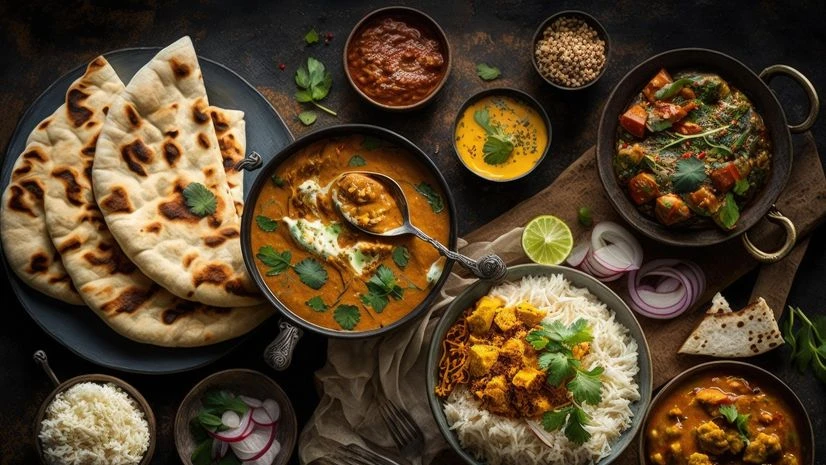Be it Bihari Champaran meat sold in roadside eateries or Mumbai Pao served to G20 leaders, state delicacies are going places
)
Food from Indian states is healthy and varied. (File photo)
Namrata KohliNew Delhi
Eating Indian Food The Right Way And To Stay Healthy
“Follow the practice of eating seasonal fruits and vegetables, which aligns with the wisdom of Ayurveda. It is believed that it is best to consume fruits and vegetables according to their seasons,” says Delhi based Dr. Sangeeta Tiwari, Clinical Dietician, Artemis Lite at New Friends Colony.
One should focus on incorporating wholegrains such as millets, maize, and cereals like sorghum and pearl millet into your diet. They are not only healthy but also versatile for various dishes. By incorporating whole grains into your diet, you can have healthy meals without compromising on taste.
Indian cooking uses herbs and spices like turmeric, ginger, garlic, and cumin for health benefits. “We must learn about the medicinal properties of spices like hing (asafoetida), ajwain (carom seeds), and fenugreek. Use them judiciously for flavour and digestive benefits,” says Tiwari.
Ragi: The forgotten superhero
What’s Trending Globally
Mango lassi is the fastest moving Indian beverage outside of India. The next decade belongs to Indian food, especially regional food. For instance, the Champaran meat is a very typical Bihari dish, but it has become so popular and everyone from top restaurants to humble dhabas are doing it. Ditto with biryani which is bursting with so much flavour and punch that the world loves it.
According to Chef Rakesh Sethi, Corporate Executive Chef, South Asia – Radisson Hotel Group, “Bihar boasts a rich heritage of culture and learning. From this historical region, culinary treasures like Champaran Meat emerged. Originating in the district of Champaran, it is a beloved dish that has captured the hearts and palates of people across the subcontinent. Over the years, this dish has evolved, and its popularity gradually spread to some adjoining places/states like Uttar Pradesh.” Sethi shares the recipe in detail- Goat meat for Champaran Meat is traditionally marinated with onions, garlic, and spices. While some recipes use a mix of mustard oil and desi ghee, others opt for just mustard oil. The meat is then placed in an earthenware pot, sealed tightly with whole wheat dough, preventing steam escape. This dish doesn't require water; it slowly cooks in its juices, dum style, for 1.5 to 2 hours. Slowly cooked over wood embers or hot charcoal, the handi is carefully shaken to prevent sticking. This culinary delight is a must-try, offering a taste of Bihar's rich gastronomic heritage.”
Finally, a caveat. Don’t overindulge in Indian fat, food and spices. “It’s a lot about timing,” says Chef Kunal Kapur- “If you are eating healthy food at midnight, it will do more harm than good. Have your last meal before sunset.”
Balance rich, creamy dishes by combining them with lighter options like daal (lentils) or grilled vegetables. Limit consumption of deep-fried snacks, as they can be high in unhealthy fats. Rather than deep frying, you can also consider shallow frying. Be cautious of sugary Indian sweets and desserts. To keep yourself away from health issues, you can opt for alternatives with reduced sugar or natural sweeteners.
"There are two things to watch out for- the nature of oil and the kind of heat you subject your food to. One should use good oil such as cold pressed oil, ghee, butter. Go for slow cooking, stir fry, pressure cooking and cooking styles which involve the minimum heating,” says Ishi Khosla, a renowned Delhi based clinical nutritionist. Talking about what is healthy in Indian non vegetarian, she says "fish is the best of the lot" in meats. "Grills, kebabs and tandoori non-veg are great too. In curries, so long as it is light gravy not using too much of oil, it is fine. A good way of taking non veg is to combine them with vegetables. What is not good is poultry with hormones. In India, red meat is ok and isn't subject to too much contamination and it's fine to have it once or twice a week."| Dish | Price (in Rs) |
| Lotus stem ships | 355 |
| Mumbai Masala Pav | 475 |
| Mini Chutney Idlis | 495 |
| Masala Khichdi | 495 |
| Champaran Meat | 685 |
| Dal Makhani | 535 |
Comments
Post a Comment